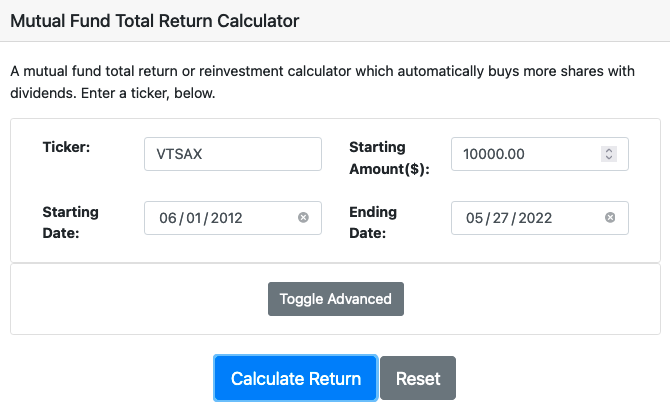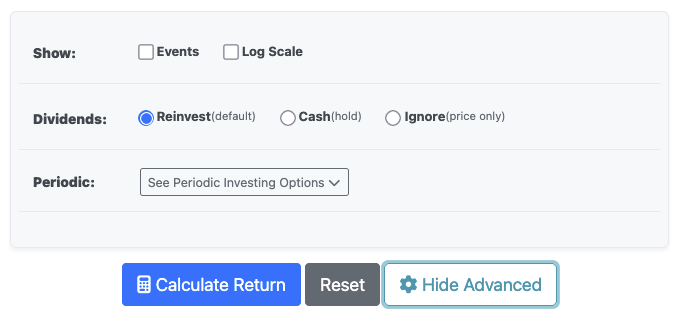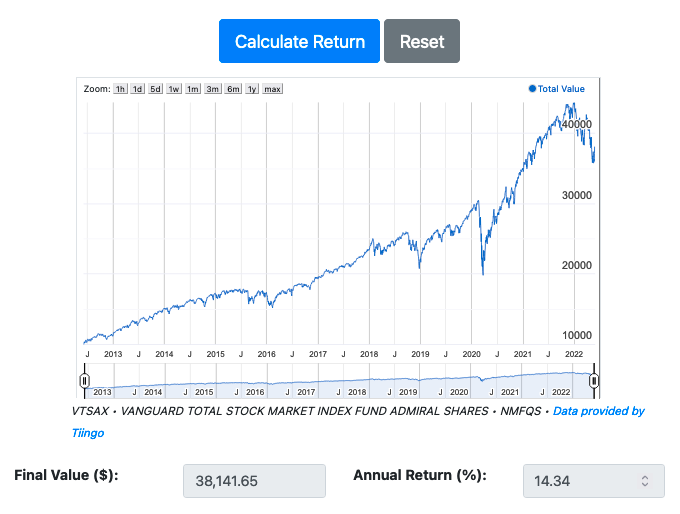On this page is a mutual fund return calculator which automatically computes an investment return, including reinvested dividends. Enter a starting amount and timeframe to estimate the growth of an investment in a mutual fund, or use the tool as a way to track index returns net of fees by entering popular tickers. Additionally, choose to simulate periodic investments into a fund by year, month, week, or day.
Next, see the Mutual Fund Drawdown Calculator, which shows the drops from local peaks and volatility in a mutual fund investment's past. Or, try the Mutual Fund Daily Moving Average Calculator or Mutual Fund Correlation Calculator.
How To Use the Mutual Fund Total Return Calculator
To begin, you need to enter at least a mutual fund ticker. Supported funds are pre-populated in the field and will autocomplete as you type.
Basic Mutual Fund Details and Inputs

- Ticker: Enter a valid, active mutual fund ticker [ZIP] from Tiingo. If it's in the DQYDJ database, you can also search by name... very useful to view fund families.
- Starting Amount ($): In dollars, the amount added to the fund on day 1
- Starting Date: Enter when an investment was first made °
- Ending Date: Enter when an investment was sold °
° Depending on the mutual fund data and market trading dates (see more below), we might adjust the starting date and ending date. Check again after your calculation.
Advanced Dividend and Periodic Investment Options

Click 'Toggle Advanced' to open the advanced mutual fund dividend and investment panel.
- Show Events: Check the box, and we'll list all our dividend and split information for the mutual fund in your timeframe. We'll also include (optionally) periodic investment information.
- Log Scale: Use a logarithmic scale for the return graph, useful for long run return charts.
Dividend Treatment Options
Next, choose how dividends are handled:
- Reinvest (default): Automatically purchase additional shares with dividend payments. This simulates a Dividend Reinvestment Plan, or DRIP. This is the canonical total return calculation.
- Cash: Hold dividend payments as cash. The final results will show the value of shares owned and cash dividends received. This option reveals an additional breakdown showing Shares Value and Cash Dividends in the results.
- Ignore: Calculate return based on stock price appreciation only.
The dividend treatment method you select is indicated below the chart after you run the tool, and the other outputs will adjust.
Periodic Investments
Simulate dollar-cost averaging (DCA) or investing over time:
- Enable Periodic Investments: Activate your regular investment simulation
- Frequency: Pick how often you make a periodic investment: Daily, Weekly, Monthly, or Annually
- Amount: The dollar amount you invest per period
When periodic investments are enabled, each investment appears as an event on the chart... if events are displayed. The tool calculates returns including the effects of dollar-cost averaging – XIRR.
Interpreting Mutual Fund Model Results

- Final Value ($): The value of the mutual fund investment on the 'Ending Date' using your starting amount and investment assumptions. Remember, the tool may change that date depending on the database refresh limit.
- Annual Return: An estimate of the annualized percentage return by the investment, including your periodic investments. See our compound annual growth calculator for more.
- Graph: The value of the mutual fund investment over time. You can hover (desktop) or tap (tablet or mobile) to see the portfolio value at a point in time.
How do the periodic mutual fund investments work?
A database backs the tool with daily prices on mutual funds, which also includes dividends and splits. Unlike with stocks or ETFs, there are no open, close, high, and low prices – mutual funds quote one price per day after market close.
And dividends or periodic investments are done at the same daily price.
Source and Methodology of the Mutual Fund Total Return Calculator
The mutual return calculator is a derivative of the stock and ADR return calculator and ETF and CEF return calculator. The tool uses the Tiingo API for its price and dividend data. Tiingo isn't free, so we have some very modest limits in place:
- ETF and CEF data may be up to 7 trading days old. Note that weekend refreshes and market holidays might mean this is over 7 'actual' days'.
- Always check the tool ending date after a scenario to see data recency of the mutual fund.
- Rate limits are in place:
- Maximum 50 calculations per day
- Maximum 10 calculations per minute
- Limits apply across all of the Tiingo calculators. You can see which ones in the methodology section.
Limitations and Disclaimers
The mutual fund total return calculated contains idealized return data. It is based on historical prices and would not match a real investor's gains exactly.
The tool is for informational purposes only. We cannot warrant any results. Mutual fund outputs are good for initial research, but please verify any information the tool outputs independently.
Note that there are other factors the tool is ignoring:
- Taxes
- Your portfolio management fees
- Dividend timing
- Other things I can't enumerate
The price or dividend datasets may be wrong too (please report if you find a bug).
Using the tool as an index fund return calculator
Many mutual funds track published indexes. You can use popular mutual funds tracking indices to estimate an investor's results tracking an index after fees.
However, note our warnings – these are idealized computations. See a fund's prospectus for the gold standard results on an investment.
Bug Reports, Feature Requests, and Requests to Help with the Mutual Fund Total Return Calculator
Let us know if you find a bug, and importantly include the fund ticker with the issue.
You can send enhancement requests, but the bar is very high. I'm not paid to build or maintain this tool (outside of the ads). For significant requests, please make a contracting inquiry.
Again, this information is for informational and research purposes only. We cannot and will not be able to help in a legal capacity. We can only help you with research inquiries. This data might be a useful starting point for your research, but for legal inquiries, you probably need a professional known as a "forensic accountant".
Mutual Funds, Dividends, and Total Returns
As I've maintained since I started tool-building on this site, dividends matter. To this day, it's ridiculous how many financial stories quote index or stock price returns when dividends eventually dominate total returns on a long enough timeline. (Non-dividend payers aside!)
But unless you are heating your house with dividend checks, losing your mail, refusing to cash checks, or some other weird scenario... your dividends are a real factor in your returns.
If you'd like to compare the mutual fund tool to a straight investment in an index or to compute fee drag:
